 The first quarter research and tracking report must start with highlighting the new additions to the Mara Elephant Project Research Department team. In January, we welcomed David Kimanzi (pictured left), a GIS specialist, that will be working closely with Wilson Sairowua and Dr. Jake Wall to collect new spatial layers, manage MEP’s EarthRanger platform, monitor all collared elephants, and produce cartographic and analytical outputs from our growing conservation datasets. Alongside Kimanzi joining MEP as the new data and reporting manager, Wilson Sairowua was promoted to director of conservation. We also officially launched a ‘long-term monitoring’ (LTM) team and hired four new team members, Vincent, Sarafina, Fintan and John. This team is equipped with a dedicated Toyota Landcruiser and is working on fulfilling two objectives: 1) individual-based sightings and re-identification of elephants across the Mara, and 2) regular, ground-based census of elephants along fixed routes within the conservancies and protected areas. They spent two weeks doing basic training alongside the spatial mapping team and learned about the various data systems in use by MEP such as EarthRanger, Cybertracker, ER Track, Njia and ElephantBook. They also undertook first-aid training and asset training to be able to operate alongside MEP’s ranger teams when needed.
The first quarter research and tracking report must start with highlighting the new additions to the Mara Elephant Project Research Department team. In January, we welcomed David Kimanzi (pictured left), a GIS specialist, that will be working closely with Wilson Sairowua and Dr. Jake Wall to collect new spatial layers, manage MEP’s EarthRanger platform, monitor all collared elephants, and produce cartographic and analytical outputs from our growing conservation datasets. Alongside Kimanzi joining MEP as the new data and reporting manager, Wilson Sairowua was promoted to director of conservation. We also officially launched a ‘long-term monitoring’ (LTM) team and hired four new team members, Vincent, Sarafina, Fintan and John. This team is equipped with a dedicated Toyota Landcruiser and is working on fulfilling two objectives: 1) individual-based sightings and re-identification of elephants across the Mara, and 2) regular, ground-based census of elephants along fixed routes within the conservancies and protected areas. They spent two weeks doing basic training alongside the spatial mapping team and learned about the various data systems in use by MEP such as EarthRanger, Cybertracker, ER Track, Njia and ElephantBook. They also undertook first-aid training and asset training to be able to operate alongside MEP’s ranger teams when needed.

The new MEP LTM team.
We wanted to highlight a very good article recently released by Joseph Ogutu and collaborators on the fencing situation. MEP’s fence data is becoming increasingly important in tackling this growing environmental issue and to that point, MEP’s three field assistants mapping fences, roads and landcover ground-truthing points recorded a total of 694 km of fences and 569 LCC points in the first quarter.
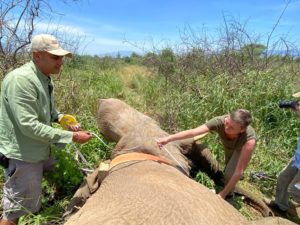 In the first quarter, Kenya Wildlife Service (KWS) and MEP welcomed two new collared elephants to our monitoring program. On March 14, KWS and MEP collared Clara (pictured left) who is part of a herd of over 50 elephants located along the Sand River, which runs between two key MEP and KWS operational areas, the Loita Hills and the Maasai Mara National Reserve. Clara was collared at Ilkerin-Loita and a few days after her collaring, she crossed the Sand River and streaked towards the Kenya-Tanzania border. The second female elephant candidate, Josephine, was collared in the Shompole area in a herd of over 100 elephants. We hope that Josephine will help us to better understand elephant movment between the Loita Forest and the Sourthern Rift. KWS and MEP also re-collared Chelsea who was spotted the first week of January by the Olkinyei Conservancy rangers with a wound on her side. On January 8, Chelsea was successfully darted and treated by KWS Vet Dr. Rono from the KWS HQ in Nairobi for a wound on her side that was obtained from a spear and was fitted with a new collar.
In the first quarter, Kenya Wildlife Service (KWS) and MEP welcomed two new collared elephants to our monitoring program. On March 14, KWS and MEP collared Clara (pictured left) who is part of a herd of over 50 elephants located along the Sand River, which runs between two key MEP and KWS operational areas, the Loita Hills and the Maasai Mara National Reserve. Clara was collared at Ilkerin-Loita and a few days after her collaring, she crossed the Sand River and streaked towards the Kenya-Tanzania border. The second female elephant candidate, Josephine, was collared in the Shompole area in a herd of over 100 elephants. We hope that Josephine will help us to better understand elephant movment between the Loita Forest and the Sourthern Rift. KWS and MEP also re-collared Chelsea who was spotted the first week of January by the Olkinyei Conservancy rangers with a wound on her side. On January 8, Chelsea was successfully darted and treated by KWS Vet Dr. Rono from the KWS HQ in Nairobi for a wound on her side that was obtained from a spear and was fitted with a new collar.
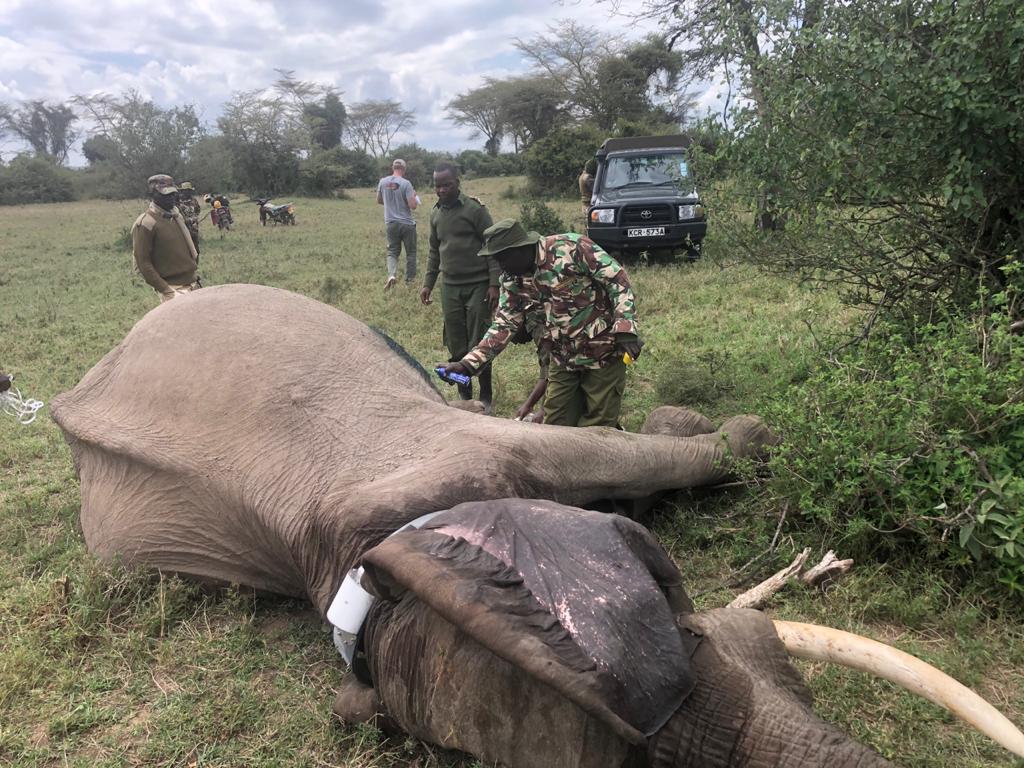
Collared elephant Chelsea’s treatment and collar replacement operation.
During the last week of January, Marc Goss and Dr. Jake Wall used the MEP leased helicopter to aerially monitor Fred, Ivy, Fitz, David, Kegol, Kiambi, Lempiris, Chelsea, Matali, Hannibal, Napoleon and two herds in Olarro Conservancy and the Southern Loita area.

Collared elephant Kiambi with his herd photographed from the MEP leased helicopter.
The rain in the Mara has meant a lot of ripe farms that many of KWS and MEP’s collared elephants have taken advantage of in the first quarter. In February, Ivy was staging during the day with her herd of 20 in Olchoro Conservancy and crossing the Mara River to nearby farms at night. What’s notable is that by March she didn’t crop raid the entire month.
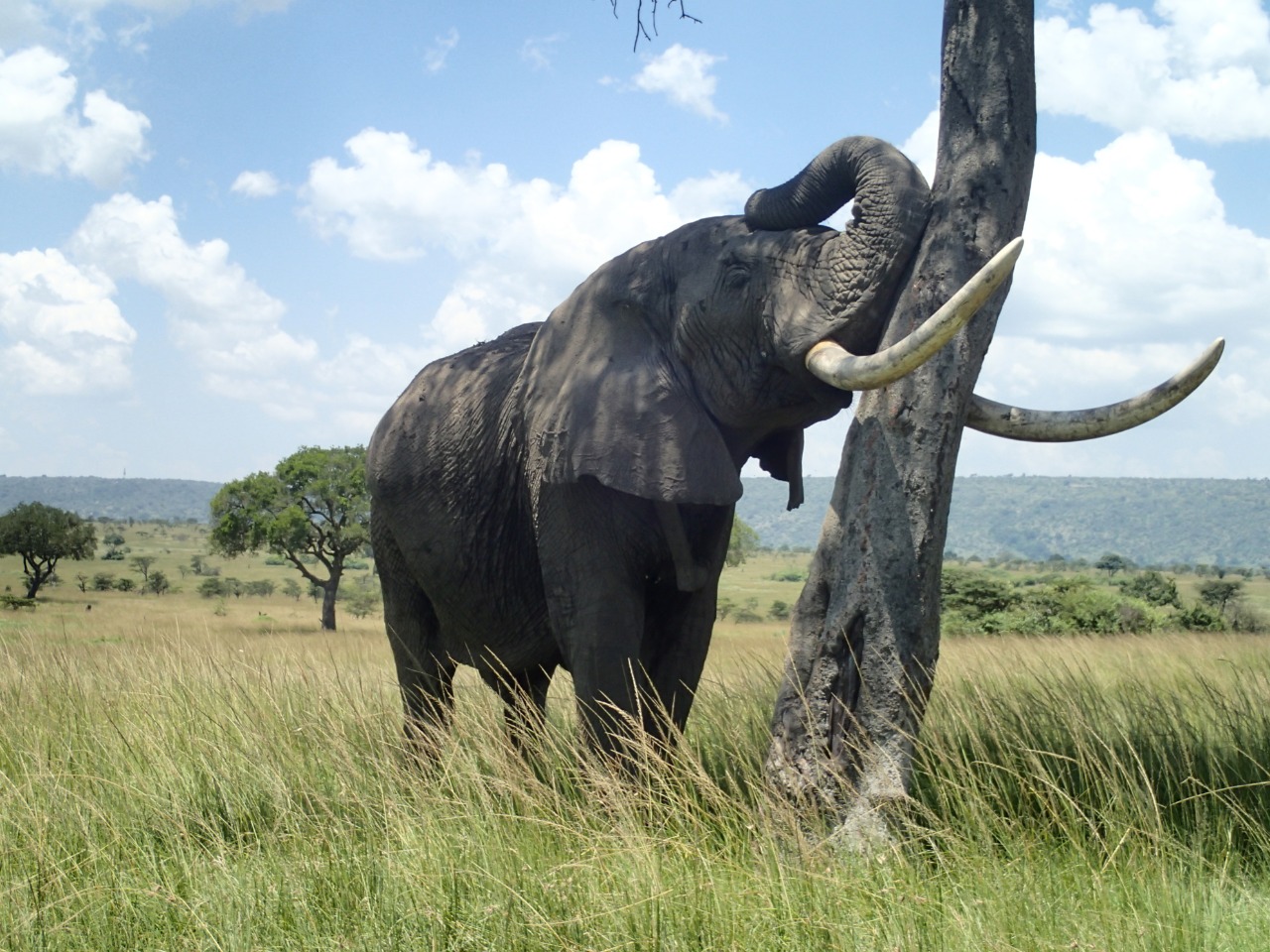
Fred enjoying a good scratch against a tree in February.
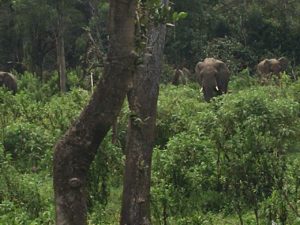 Fitz (pictured left) continued with his high crop raiding behavior staging in the forest and then going into farms at night. He and his herd of 60 continued raiding crops around the Nyakweri Forest and breaking geo-fences but MEP’s Alpha team on ground were stationed there to keep him and the community safe. MEP had to deploy the helicopter at one point to move Fitz and his herd back into Dupoto Forest from the western edge of the forest which is experiencing a huge amount of destruction. Hannibal and Napoleon were in the southern slopes of Mt. Suswa at the start of January. They both left the Suswa area and moved about 50 km farther south into Mosiro, where they spent time in unprotected areas. In the second week of January, both bulls left Mosiro at dusk and moved south-west into the riverine thicket of Ewuaso Ngiro to crop raid under the cover of darkness. They broke a geo-fence and whizzed through dense farms in Ewuaso Ngiro South. The crop-raid seemed well strategized starting at around sunset entering the farms at midnight and heading back at the crack of dawn.
Fitz (pictured left) continued with his high crop raiding behavior staging in the forest and then going into farms at night. He and his herd of 60 continued raiding crops around the Nyakweri Forest and breaking geo-fences but MEP’s Alpha team on ground were stationed there to keep him and the community safe. MEP had to deploy the helicopter at one point to move Fitz and his herd back into Dupoto Forest from the western edge of the forest which is experiencing a huge amount of destruction. Hannibal and Napoleon were in the southern slopes of Mt. Suswa at the start of January. They both left the Suswa area and moved about 50 km farther south into Mosiro, where they spent time in unprotected areas. In the second week of January, both bulls left Mosiro at dusk and moved south-west into the riverine thicket of Ewuaso Ngiro to crop raid under the cover of darkness. They broke a geo-fence and whizzed through dense farms in Ewuaso Ngiro South. The crop-raid seemed well strategized starting at around sunset entering the farms at midnight and heading back at the crack of dawn.
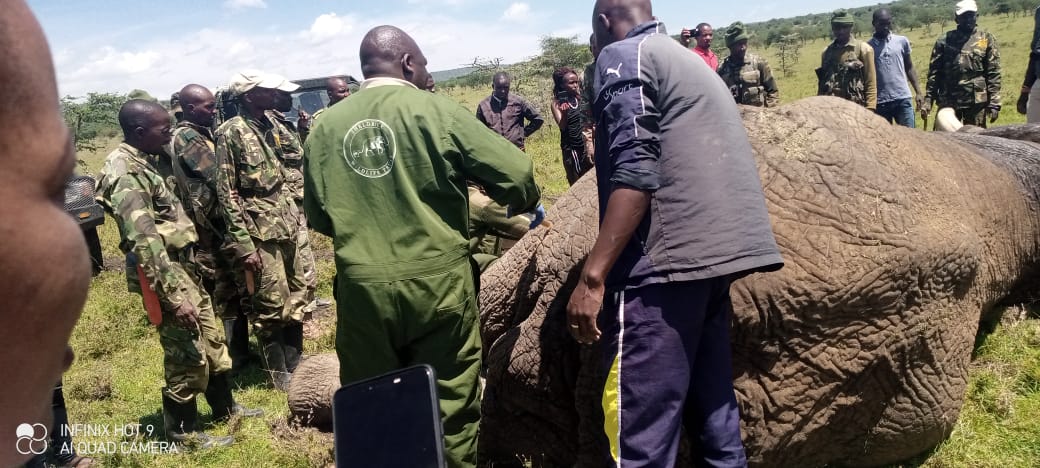
Lempiris received vet treatment in late February for a sprained ankle and his speed was low in early March but improved progressively over time and soon he was back to his typical crop raiding behavior.


